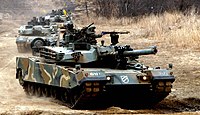
Photo from wikipedia
The article discusses the effect of residual stresses on the fatigue strength of torsion bars by using the Dang Van fatigue criterion, at the stress concentration at the root of… Click to show full abstract
The article discusses the effect of residual stresses on the fatigue strength of torsion bars by using the Dang Van fatigue criterion, at the stress concentration at the root of the tooth and at the smooth part of the torsion bar. Residual compressive stresses were induced on the surface during the technological processes by cold surface rolling and torsional pre-strain (pre-setting) to the plastic range, to increase the elastic linear range and to reduce the stress state during torsional loading. Normally, the stress reduction in the torsion bar at the mounting point is provided by the increased diameter of the splined part, compared to the smooth part of the torsion bar. In the case of a small difference between the diameter of the splined and the smooth parts of the torsion bar, a fatigue crack can be initiated in the notch, which causes the torsion bar to break during operation after a few hundred loading cycles. FEM stress analysis of a torsion bar was performed in the article. The actual residual stresses were measured by the non-destructive X-ray method at the place of stress concentration on the smooth and splined parts with a notch of the torsion bar, and Dang Van’s failure criterion was used to determine the fatigue behavior during torsional loading. Therefore, in the paper, the three methods were combined to determine the optimum lifetime of a torsion bar exposed to the required cyclic torque. The results of the analysis showed that the residual compressive stresses are useful up to a certain limit where the retarded fatigue crack initiation occurred, but a further increase of compressive stress caused an increase of the maximum shear stresses, which, in turn, caused the initiation of fatigue and failure at the splined part of the torsion bar before achieving the required number of cycles.
Journal Title: Metals
Year Published: 2023
Link to full text (if available)
Share on Social Media: Sign Up to like & get
recommendations!